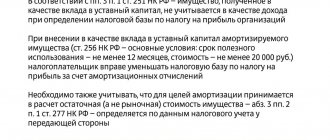Authorized capital: postings
The content of the article
Authorized capital is part of the organization’s own capital, representing the amount of funds invested by the owners to ensure authorized activities recorded in its constituent documents. This value determines the minimum size of property that guarantees the interests of creditors. Depending on the organizational and legal form, the authorized capital of an organization may be called authorized capital, mutual fund, or share capital. We will talk about synthetic and analytical accounting of authorized capital in our consultation.
The credit balance of account 80 must correspond to the amount of the authorized capital recorded in the constituent documents of the organization. This means that accounting entries for account 80 are made only after appropriate changes have been made to the constituent documents.
Amount of authorized capital
The minimum amount of capital is established by the Civil Code and laws on business companies:
- for LLC - 10,000 rubles (Clause 1, Article 14 of Federal Law No. 14-FZ);
- for organizers of gambling through bookmakers or sweepstakes - 600 million rubles (Clause 9, Article 6 of Federal Law No. 244-FZ);
- for banks and credit organizations - from 90 million to 1 billion rubles (Article 11 of Federal Law No. 395-1).
The LLC must maintain the minimum amount of authorized capital throughout its activities. If the amount of net assets turns out to be less than the authorized capital for more than 2 tax periods, the company must either reduce the authorized capital, and if this is not possible, then make a decision on liquidation.
https://www.youtube.com/watch?v=upload
Depositing funds to LLC occurs in compliance with the following rules:
- 10,000 rubles are deposited in cash;
- anything over the minimum size can be entered as property;
- property must have an assessment if the nominal share of the property contribution exceeds 20,000 rubles;
- The deadline for making contributions by the founders is no later than 4 months from the date of state registration.
Accounting for authorized capital and settlements with founders (account 80 and 75)
Why do you need authorized capital? It forms start-up capital, which is used in the commercial activities of the enterprise, that is, it is the basis for further activities. In addition, the founders are liable for the debts of the enterprise within the framework of their shares in the authorized capital. That is, for creditors this is the minimum amount of property that they can return, a kind of guarantee of return of funds.
But that is not all. The formation of authorized capital is a business transaction, and for each operation we must carry out accounting entries using the double entry principle. Details on how to make postings are written here. In short, from the Chart of Accounts you need to select two accounts involved in the business transaction associated with the formation of the authorized capital, and make a simultaneous entry for the debit of one and the credit of the other.
Where does the management company of an LLC go when the organization is closed?
In order to create and officially register a legal entity as an LLC, the founders need to form the appropriate authorized capital for it.
The minimum acceptable amount of capital for an LLC is 10,000 (ten thousand) rubles. The maximum possible value is not limited by law, but may be limited by the constituent documentation of a business company. The management company is formed and replenished from founders' contributions.
It is allowed to contribute to the authorized capital both cash and non-monetary assets, valued and reflected on the balance sheet in monetary equivalent (property).
The authorized capital can be paid (contributed) by the founders for four months, counted from the date of official registration of the LLC. Payment procedure for the Criminal Code.
When an organization becomes a registered legal entity, its authorized capital formed by the founders and the corresponding assets transferred by the owners are recorded in accounting records.
Monetary assets are accounted for in the current account or cash register of a legal entity.
Non-monetary assets are reflected in the accounting accounts of the corresponding values and are accepted by transfer and acceptance acts.
When an LLC completely ceases its activities and is liquidated, the issue of returning to the founders the funds previously contributed to the authorized capital of the legal entity becomes relevant.
A significant role in this case is given to the reason why the company is finally closed. Liquidation of an LLC can occur either compulsorily or voluntarily.
Postings 75 of the account for contributions to the authorized capital: to the current account, in the form of fixed assets and intangible assets
The fundamental procedure for creating any organization is the formation of its authorized capital. Founders and shareholders can use both cash and fixed assets (real estate, cars, equipment, etc.) as a contribution. The authorized capital is accounted for in accounting account 75. From this article you will learn how to reflect the founder’s contribution to the authorized capital in the transactions, depending on its type.
In order for an organization to be registered, it is necessary to contribute at least 50% of the authorized capital. But it should be noted that the legislation provides an exception for such an organizational and legal form as a joint-stock company. A joint stock company can obtain state registration without contributing authorized capital. But at the same time, half or more of the amount of the authorized capital must be paid for a period of no more than 3 months after state registration, the rest - no later than a year.
Contribution to the authorized capital: postings
Within 4 months from the date of registration of the Company, the founders must contribute their shares. 10,000 can be deposited only in money, and amounts exceeding the minimum amount of the authorized capital can be deposited with property. Funds are deposited into the cash desk or into the organization's current account, if it is already open.
Contribution of authorized capital to the cash desk, postings: Dt 50 Kt 75.01.
Contribution to the current account: Dt 51 Kt 75.01 - when transferred from an individual’s current account or when deposited through a bank branch.
Property contribution: Dt 01 (04, 10, 41, 58, 66, 76, 97) Kt 75.01 for the amount of property valuation.
When creating the entry “contribution to the authorized capital through the cash register,” you should take into account the cash limit and funds exceeding the limit that can be deposited into the LLC’s current account.
In the process of economic activity, the amount of the capital may change up or down by the decision of the founders.
Return of part of the authorized capital to the founder-individual
In the event that the value of the corresponding part of the share is returned to the company's participants, or in the event that the authorized capital is reduced in accordance with the requirements of the legislation of the Russian Federation, the amount of such reduction in the authorized capital will not be included in the tax base when calculating income tax.
As already stated above, in accordance with Art. 66 of the Civil Code of the Russian Federation, property created through the contributions of founders (participants), as well as produced and acquired by a business partnership or company in the course of its activities, belongs to it (that is, the company) by right of ownership.
Capital contribution
When an enterprise is formed, as well as a change in the size of the authorized capital (registered in accordance with the law), the founders can transfer fixed assets, including motor vehicles, to the enterprise as a contribution . In accordance with clause 3.3 of PBU No. 6/01, the initial cost of fixed assets contributed to the contribution to the authorized (share capital) of the organization is recognized as their monetary value, agreed upon by the founders of the organization. In this case, the contribution can express the value of the car at the residual price, higher or lower than the original cost according to the documents of the transferring party.
In accordance with clause 2.13 of Instruction No. 37, property merged by enterprises for the purpose of joint activities is not subject to income tax. The property of legal entities united by the parties to the agreement for joint activities is accounted for on the joint balance sheet of the participant who, in accordance with the agreement, is entrusted with managing the common affairs of the parties to the agreement. This participant acts on the basis of a power of attorney signed by the other parties to the agreement.
Is it possible to return the authorized capital in bankruptcy?
As practice shows, if it comes to bankruptcy, then the founders cannot count on the return of the authorized capital. In order to repay debts to creditors, all monetary assets and material resources, including the capital, are used. Moreover, as a rule, the management company goes to repay the debt in full.
Let's summarize. The right to return the authorized capital arises in various cases: it is possible to receive your share in cash both during the liquidation of the company and in some other situations. But, given the complexity of this procedure, as well as the complexity of the current legislation, it is impossible to do without qualified legal support in returning the capital.
Sources:
Civil Code of the Russian Federation Article 63. Procedure for liquidation of a legal entity
Civil Code of the Russian Federation Article 67. Rights and obligations of a participant in a business partnership and company
Tax Code of the Russian Federation Article 277. Peculiarities of recognizing income and expenses when transferring property (property rights) to the authorized (share) capital
Accounting accounts 80 and 75
First of all, with its help, start-up capital is formed for the subsequent commercial activities of the enterprise. It consists of contributions from the founders, which can be either in the form of tangible property or in cash. Each founder has his own certain share in the capital, depending on its size, he will subsequently receive the corresponding profit from the commercial activities of the enterprise (dividends). The company is responsible for its obligations within the framework of this capital, so for creditors this is a kind of guarantee of satisfaction of their interests.
Authorized capital is the initial amount of funds (start-up capital) that the founders are willing to invest to ensure the activities of the enterprise. When registering an organization with the relevant authorities, constituent documents are drawn up, which include the cost of the authorized capital.
Chapter 2
Thus, it is up to the court to determine whether a company’s violation of its registration procedure is gross or irreparable. Therefore, the requirements of Article 20 of Law No. 14-FZ themselves cannot serve as an automatic basis for the liquidation of the company. Whether the company is liquidated or not will be decided by the court, taking into account the nature of the violations committed by the company and the consequences caused by them.
There are also intangible assets for which it is impossible to determine their useful life. Then this period is taken equal to 20 years (but, of course, not more than the life of the company itself). Let us immediately draw the attention of readers to the fact that for tax accounting purposes for the same intangible assets, the useful life is set within 10 years (and also no more than the period of activity of the taxpayer himself). This is stated in paragraph 2 of Article 258 of the Tax Code of the Russian Federation.
Formation of authorized capital: accounting entries
The authorized capital is the amount that the founders contribute after registering the company. It is displayed in the liability side of the balance sheet, since it is the source of the formation of assets. The founders can make contributions in the form of cash, non-cash funds, materials, fixed assets. The activities of the enterprise are financed from the funds of the management company.
How is the formation of authorized capital reflected in accounting? Postings depend on the sources of funds. To account for the authorized capital, accounts 80 and 75 are used. Receipts of funds are reflected in credit 75, and write-offs are shown in debit 75. The entry drawn up when forming the authorized capital in joint-stock companies looks like this: DT75 KT80 - the debt of the founders is reflected in the Criminal Code. Each owner must contribute to the capital in accordance with his share. Profits will then be distributed in the same ratio.
The authorized capital has been formed and declared - what posting is necessary?
Commercial legal entities (PJSC, JSC, LLC, business partnerships, state unitary enterprises, municipal unitary enterprises) are created with the mandatory formation of an authorized capital (MC). The size of the management company, the share of participation in it of each of the founders, payment terms, form of contributions and assessment of non-monetary contributions are stipulated in the constituent agreement.
The authorized capital is the starting amount of funds with which a legal entity begins its activities. After completion of all activities for making contributions to the authorized capital, postings begin with the corresponding entry made on the date of its registration. It should reflect the accrual of the full amount of the capital provided for by the charter, in correspondence with the debt of the founders on contributions to it: Dt 75 - Kt 80.
Analytics on account 80 (accounting capital account) is organized according to:
- founders (participants);
- stages of formation (in PJSC, JSC and business partnerships);
- types of shares (in PJSC and JSC).
Account 75 is the account for settlements with the founders. The debit balance of its subaccount, reserved for settlements of contributions to the capital account, will show the amount of the unpaid capital account.
To learn how the capital account will be reflected in the accounting records, read the article “Procedure for drawing up a balance sheet (example).”
Authorized capital: postings
- Cash:
- cash;
- non-cash;
- Inventory assets:
- equipment (Deb. 01);
- vehicles (Deb. 01);
- goods (Deb. 10);
- materials (Deb. 10);
- Intangible assets:
- patents (Deb. 08.5);
- know-how (Deb. 08.5);
- licenses (Deb. 08.5);
- franchises (Deb. 08.5);
- agreement on assignment of rights (Deb. 08.5);
- shares, bonds of third legal entities. (Deb. 58);
Account No. 80 is inactive, but passive. Account 80 is necessary to summarize information about the movement and general condition of the organization's management company. Account balance 80 should be equal to the capital specified in the organization’s charter. Any movements in the MC account occur when a MC is created or changed (increased or decreased).
Basic entries used for authorized capital
The authorized capital is created through founders' contributions, expressed in the form of cash or any property assets. There are often cases when founders invest not just money, but fixed assets or tangible assets that can be used in the production and economic process. In this regard, contributions to the authorized capital must be correctly allocated to accounting accounts.
When funds or property are transferred by participants for the purpose of contributing to the authorized capital, this action must necessarily be reflected in the accounting accounts. In other words, after the shares themselves have been reflected as a credit of 80 and a debit of 75, we show the components of the shares. Examples of correspondence regarding cash and material property include the following postings:
During liquidation there is no money to return the authorized capital
Is it possible to return the authorized capital?
Let us note that in the process of liquidation or declaring legal organizations bankrupt, the process of returning the authorized capital to the founders is allowed. The process of dividing shares takes place only after satisfying the claims of creditors, since any company (if there are debts at the time of liquidation) must pay off its creditors (including employees) to the maximum extent possible.
The process of returning the authorized capital to the founders, as well as other issues related to the liquidation and bankruptcy of legal entities, is regulated by the following regulatory and legal acts:
- Civil Code of the Russian Federation (Articles 61 - 67);
- Federal Law No. 14 of 02/08/1998 “On Limited Liability Companies” (Articles 57 and 58);
- Federal Law No. 208 of December 26, 1995 “On Joint Stock Companies” (Articles 21 - 24);
- Federal Law No. 161 “On the National Payment System” dated December 29, 2014;
- Federal Law No. 127 “On insolvency (bankruptcy).
We will consider specific points regarding the process of returning the authorized capital to the founders below.
Authorized capital upon liquidation
When the tax authority decides to suspend transactions on the accounts of a liquidated company, the rights of participants to register ownership of the received property are limited. In this case, they have the opportunity to go to court (Resolution of the Federal Antimonopoly Service of the Moscow Region dated April 28, 2011 No. KG-A40/3403-11, Resolution of the Federal Antimonopoly Service of the East Siberian District dated March 23, 2009 No. A69-4315/08-F02-1027/09). If the founders, in violation of the procedure established by law, take away the property before full settlement with creditors, then such property can be demanded from them.
If it is impossible to return the property in kind, its value is claimed.
- All property is subject to distribution if the legal entity has no obligations to creditors. In this case, compliance with two basic conditions is mandatory. Firstly, the period for receiving claims from creditors is two months. The period must be counted from the date of publication of the liquidation record in the Bulletin. Secondly, the compiled interim liquidation balance sheet must reflect all settlements with creditors.
- Only the part of the property remaining after full settlement of debts will be distributed. The remaining funds must be entered into the liquidation balance sheet.
- The property is not distributed or transferred to the company's participants, since it is not available after settlements with creditors. Such information is also entered into the balance sheet.
After its creation, the liquidation commission develops and approves a plan for the liquidation of the enterprise, which begins with a complete inventory. In accordance with subparagraph 27 of the Order, an inventory is required of a legal entity at the beginning of the liquidation procedure. All positions of assets and liabilities are subject to inventory. If discrepancies are identified between accounting data and the actual availability of property, they must be reflected in the accounting accounts. 100% of the authorized capital of a Russian LLC that is in the process of liquidation belongs to another Russian organization. In 2011, the LLC acquired a stake in the authorized capital of an organization that is a resident of the Republic of Belarus; the cost of the contribution to the authorized capital was determined in US dollars; as payment for the share in the authorized capital, the company transferred an object of fixed assets.
This financial investment has not been revalued by the organization. The LLC applies a general taxation system. What is the procedure for accounting and tax accounting (profit tax) for a liquidated organization of the transaction of transferring to the sole participant a contribution to the authorized capital of a Belarusian organization? Let us recall that in accordance with the Instructions for the application of the Chart of Accounts for accounting the financial and economic activities of organizations, approved by order of the Ministry of Finance of Russia dated October 31, 2000 N 94n, information on the availability and movement of financial investments is reflected in account 58 “Financial investments”, and all settlements with LLC participants are reflected in account 75 “Settlements with founders (see also the letter of the Ministry of Finance of Russia dated 03.07. 2007 N 07-05-12/06). In accordance with Part 3 of Art. 62 of the Civil Code of the Russian Federation (hereinafter referred to as the Civil Code of the Russian Federation), after approval of the decision to liquidate a legal entity, a liquidation commission is to be formed, whose task is to conduct the liquidation procedure and determine its terms.
The commission will carry out its activities at all stages of liquidation of a legal entity, including taking part in the distribution of property between the founders. If a company has been active and functioning at all stages of its existence, it is possible that it may accumulate debts. Debt settlement is an integral part of the liquidation procedure and the further distribution of property between the company's participants.
Return of authorized capital to the founder upon liquidation of a legal entity ↑
The termination of the activities of any organization must be carried out strictly according to the regulations prescribed by law.
During the liquidation of an LLC, the authorized capital can be distributed among the participants only after the completion of payments to creditors.
The return is made on the basis of the final liquidation balance, that is, the amount remaining after settlement of debts.
Sometimes the volume of accounts payable exceeds the sum of assets and liabilities, which is why the final line of the liquidation balance sheet is filled with a negative value.
But this does not mean that the founders are obliged to invest their funds. Forecasting similar situations ensures the creation of an interim balance sheet, which takes into account all expenses for repaying debts.
The founders are liable to creditors only to the extent of their shares. A positive liquidation balance leads to a redistribution of the remaining amount of capital between participants.
If the balance is zero, the founders are deprived of their shares in the capital. In case of bankruptcy, the entire amount of the authorized capital goes to pay off debts.
The founders cannot claim their share, regardless of the level of their participation in the organization's activities.
Step-by-step instruction
The instructions for returning the authorized capital to the founder upon liquidation are as follows:
| General meeting of founders or sole participant | Decides to liquidate the organization, documenting its resolution with a protocol or decision of the sole founder |
| The protocol establishes the procedure | Its terms and composition of the liquidation commission |
| Notified of impending liquidation | Tax authorities |
| A printed advertisement is given in the media | On the liquidation of such and such a company and the acceptance of claims from creditors for a certain period |
| The commission examines the organization's reporting | And determines the amount of accounts payable |
| Settlements with creditors are carried out | We also pay salaries to employees and pay all necessary taxes. |
| From the remaining amount | Participants are paid distributed profits |
| Remaining assets | Divided between the founders based on the size of the share |
By sending a payment order to the bank or by paying out funds through the company's cash desk, the authorized capital is returned to the founder upon liquidation.
The purpose of the payment in the order is indicated as “Return of authorized capital”. Each participant in the company can claim only that part of the authorized capital that corresponds to his actual share and no more.
The duration of liquidation of an organization is not limited by law. In practice, the process lasts from several months to several years. At the same time, the return of the authorized capital to the founder is impossible until the end of the liquidation.
In case of bankruptcy, the authorized capital is used in full to pay off debts during bankruptcy proceedings. To carry out settlements, property values are sold and monetary assets are used.
The same funds are used to pay legal costs and the services of an arbitration manager. If, after all calculations and payments are completed, some part of the funds is still retained, then it is distributed in proportion to the shares among the participants of the organization.
Related documents
The return of the authorized capital to the founders upon liquidation is carried out in 2021, as before, on the basis of an appropriate act.
It states how the property will be divided in proportion to the shares of the participants. The finished deed is signed by all founders.
Article 63 of the Civil Code of the Russian Federation provides that after completion of settlements on accounts payable, a liquidation balance sheet is drawn up.
This document represents the final financial statements of the organization. It displays all assets remaining after liquidation. If there are losses, they are compensated from the authorized capital.
Before dividing the remaining funds, the company's participants must decide on the payment of the authorized capital upon liquidation.
The decision is documented in the usual manner. If there is a single founder, the return of the authorized capital is carried out on the basis of his decision.
Reflection of transactions by postings
In the event of voluntary liquidation of an organization, the authorized capital is displayed as a liability. The posting is made to the debit of account 80.
Corresponding credit accounts become account 84 “Undistributed loss” or account 99 “Profits and losses”.
When making settlements with company participants, the authorized capital is reflected as follows:
Dt80 Kt75
When the management company has property value, then transactions on account 80 can correspond on the loan with accounts 01 “Fixed assets”, 41 “Goods”, 51 “Current account”. After making such transactions, the organization can close the organization's current account.
In accordance with Order of the Ministry of Finance No. 44, in the event of liquidation of an LLC through reorganization, the founders do not need to necessarily indicate the transfer of the authorized capital to the legal successor.
However, in practice, correspondent accounts 00 are used to structure accounting.
What to do with the authorized capital upon liquidation of an LLC
All savings that remain after settlements with creditors are divided between the founders in the shares that were contributed when drawing up the authorized capital. The accountant's task is to determine the market value of the property and the actually paid shares. If the price of the former is higher than the initial contribution of the founder, then the difference is written off as assets received free of charge.
If the amounts are equal, then the amount written off is not taxable. If losses occur, the value of the contribution made to the management company is also not subject to taxation.
- organize a general meeting of founders;
- approve the decision to liquidate the LLC and form a liquidation commission;
- notify the tax office of the upcoming liquidation;
- submit an announcement to the media (specialized magazine “Bulletin of State Registration”) about the closure of the enterprise and the acceptance of claims from creditors;
- determine the amount of accounts payable by forming an interim liquidation balance sheet;
- make settlements with creditors, employees and other authorities;
- pay profit to the founder;
- approve the liquidation balance sheet (final);
- Submit an application for registration of liquidation, a liquidation balance sheet, and a receipt for payment of the state duty to the registering authority.
5. Appeal the actions or inaction of the Company to the Federal Service for Supervision in the Sphere of Communications, Information Technology and Mass Communications or in court if a citizen believes that LLC Legal Company “Start” is processing his personal data in violation of the requirements of Federal Law No. 152 -FZ “On personal data or otherwise violates his rights and freedoms. Processing of personal data is any action (operation) or set of actions (operations) performed using automation tools or without the use of such means with personal data, including collection, recording, systematization, accumulation, storage, clarification (updating, changing), extraction, use, transfer (distribution, provision, access), depersonalization, blocking, deletion, destruction of personal data;7) Personal data is stored in a form that allows you to identify the subject of personal data no longer than required by the purposes of processing personal data, unless the period for storing personal data is established by federal law, an agreement to which the subject of personal data is a party, beneficiary or guarantor. The processed personal data is subject to destruction or depersonalization upon achievement of the processing goals or in the event of loss of the need to achieve these goals, unless otherwise provided by federal law.
- if one of the LLC participants has not been paid his part of the profit, division of the authorized capital (hereinafter referred to as the authorized capital) may only be possible after all payments have been made;
- in the event that the liquidation balance indicator is negative, then first it is repaid at the expense of the authorized capital, and then the property is divided between the participants of the LLC;
- If a company declares itself bankrupt, debts are covered from the authorized capital, and then the remaining amount is divided among the participants.
How is capital returned upon liquidation?
According to current legislation, the founders have the right to withdraw their share of the capital company after the liquidation of the company. It should be noted that the activities of a company can be terminated either voluntarily or forcibly (for example, if a legal entity was engaged in illegal activities, was created in violation of the law, etc.). The most common reasons for voluntary liquidation are:
- reduction in profit margins or its complete absence;
- achieving the goal for which the company was created;
- the emergence of insoluble contradictions between the founders;
- exit of all participants (for example, the founders no longer want to do business).
When a company is liquidated, the right to return the authorized capital can be exercised only after all settlements with creditors have been completed. What does this mean? If the liquidated organization does not have enough resources to repay debts to creditors (this often happens), then the property of the legal entity itself will be used to cover the debts.
A more favorable situation for the founders occurs when the company has no debts or, after completing settlements with creditors, some part of the property remains. The Civil Code of the Russian Federation contains a rule according to which the founders are given the absolute right to receive residual funds. You can receive them in the following form:
- property (this could be equipment, materials, etc.);
- money.
In this case, the liquidation commission must first divide the profit between the founders, and only then distribute the property based on the shares of the authorized capital. If the founders’ shares in the management company were unequal, then the payments, accordingly, will not be so.
The direct return of the authorized capital occurs on the basis of the relevant act. The document sets out how the division of capital will take place between the founders of the company. After drawing up the act, all participants must sign it.
After settlements with creditors are completed, a liquidation balance sheet is drawn up (Article 63 of the Civil Code of the Russian Federation). The decision to return the authorized capital to the participants of the legal entity is made and documented before the start of the process of dividing the remaining funds. If there was only one participant in the company, then he independently makes the decision to return.
Important! The authorized capital is returned through the bank (a payment order is sent to the banking organization) or through the company's cash desk. If the payment will be made through a bank, the purpose of the payment should be indicated in the payment order - “Return of authorized capital”.
Systematization of accounting
The main goal of any business enterprise is to earn a profit in the amount necessary to ensure normal functioning, including investing in assets and using the profits for consumption. At the same time...Lyudmila Dmitrievna is simply burning! Of course they are... is. yes, after all, he may not take part in management, and be the founder of 5 companies at once - at the same time, for him, everything brings profit and is an object of investment. Securities can be divided into debt and equity. Debt securities are all types of securities that give their owner the right to return
by a certain date the amount lent to them and a fixed income. Debt securities...If there are securities, there is a market, there are no securities and there is no market.
That's the whole secret. Well, I don't think it's a difficult question. Go to the websites of investment companies, or just search on the Internet. Shares, bonds, derivatives market and how you can use it... when closing an LLC after repaying all debts, the authorized capital
and the remaining property is divided between the founders according to the Charter (becomes property). After this, you can safely register an individual entrepreneur.
Individual entrepreneur has authorized capital
no, so nothing...maybe just issue an invoice for all the goods for 1p... Sell in installments, and after
liquidation
pay off the debt. Listen to STELLA until she says “But this option is possible... Because if you show the implementation (within OSNO), you will have to pay VAT...ed. Federal Law of December 28, 2002 N 185-FZ) A share is an issue-grade security that secures the rights of its owner (shareholder) to receive part of the profit of a joint-stock company in the form of dividends, to participate in the management of a joint-stock company... you need an economic dictionary Zhanna... here is a link to the library everything is there. SHARES (from the Dutch actie, German aktie) securities issued by joint-stock companies, companies, commercial banks, without... In contrast to compulsory motor liability insurance (damage insurance), under CASCO (that is, under a voluntary insurance agreement) there may be certain problems.
However, with the revocation of the license, the insurer’s responsibilities do not cease. He is obliged to settle everything within six months... Compensation payments are provided only by the law on compulsory motor liability insurance; as for CASCO, there is no one to present losses to. I’ve already had a lawsuit with this company, if you’re interested, write to the soap also via Casco. No way. To the court and to the RSA. To receive...The joint stock company issues exclusively issue-grade securities, which by their definition cannot but be registered, so Yuri’s answer is incorrect.
A joint stock company has the right to issue shares and bonds. Since the bonds... are registered, the owner of which must be registered in the appropriate register. When reselling registered shares, the coordinates of the new owners must be entered. Most often, these shares are used to analyze the shareholder structure, with the aim of... During liquidation, there is no money to return the authorized capital






